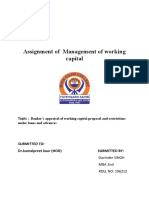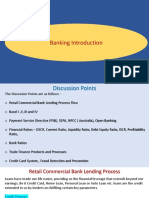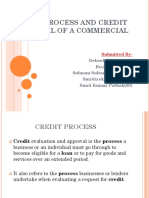0 ratings0% found this document useful (0 votes)
191 viewsComponents of Credit Appraisal Process
Components of Credit Appraisal Process
Uploaded by
minushastri33The document outlines the key components of a bank's credit appraisal process. It discusses that banks need to gather information about an applicant's income, age, education, employment history, assets, liabilities and more. The applicant's income is the most important factor in determining creditworthiness. Banks have internal norms to assess if applicants fit the eligibility criteria. Based on the applicant's parameters, banks can determine the maximum loan amount. The document groups the key assessment parameters into technical feasibility, economic viability, and bankability. Banks also check an applicant's CIBIL score as part of the process.
Copyright:
© All Rights Reserved
Available Formats
Download as DOCX, PDF, TXT or read online from Scribd
Components of Credit Appraisal Process
Components of Credit Appraisal Process
Uploaded by
minushastri330 ratings0% found this document useful (0 votes)
191 views1 pageThe document outlines the key components of a bank's credit appraisal process. It discusses that banks need to gather information about an applicant's income, age, education, employment history, assets, liabilities and more. The applicant's income is the most important factor in determining creditworthiness. Banks have internal norms to assess if applicants fit the eligibility criteria. Based on the applicant's parameters, banks can determine the maximum loan amount. The document groups the key assessment parameters into technical feasibility, economic viability, and bankability. Banks also check an applicant's CIBIL score as part of the process.
Original Description:
Components of Credit Appraisal Process
Copyright
© © All Rights Reserved
Available Formats
DOCX, PDF, TXT or read online from Scribd
Share this document
Did you find this document useful?
Is this content inappropriate?
The document outlines the key components of a bank's credit appraisal process. It discusses that banks need to gather information about an applicant's income, age, education, employment history, assets, liabilities and more. The applicant's income is the most important factor in determining creditworthiness. Banks have internal norms to assess if applicants fit the eligibility criteria. Based on the applicant's parameters, banks can determine the maximum loan amount. The document groups the key assessment parameters into technical feasibility, economic viability, and bankability. Banks also check an applicant's CIBIL score as part of the process.
Copyright:
© All Rights Reserved
Available Formats
Download as DOCX, PDF, TXT or read online from Scribd
Download as docx, pdf, or txt
0 ratings0% found this document useful (0 votes)
191 views1 pageComponents of Credit Appraisal Process
Components of Credit Appraisal Process
Uploaded by
minushastri33The document outlines the key components of a bank's credit appraisal process. It discusses that banks need to gather information about an applicant's income, age, education, employment history, assets, liabilities and more. The applicant's income is the most important factor in determining creditworthiness. Banks have internal norms to assess if applicants fit the eligibility criteria. Based on the applicant's parameters, banks can determine the maximum loan amount. The document groups the key assessment parameters into technical feasibility, economic viability, and bankability. Banks also check an applicant's CIBIL score as part of the process.
Copyright:
© All Rights Reserved
Available Formats
Download as DOCX, PDF, TXT or read online from Scribd
Download as docx, pdf, or txt
You are on page 1of 1
Components of Credit Appraisal Process
While assessing a customer, the bank needs to know the following
information: Incomes of applicants and co-applicants, age of applicants,
educational qualifications, profession, experience, additional sources of
income, past loan record, family history, employer/business, security of
tenure, tax history, assets of applicants and their financing pattern, recurring
liabilities, other present and future liabilities and investments (if any). Out of
these, the incomes of applicants are the most important criteria to
understand and calculate the credit worthiness of the applicants. As stated
earlier, the actual norms decided by banks differ greatly. Each has certain
norms within which the customer needs to fit in to be eligible for a loan.
Based on these parameters, the maximum amount of loan that the bank can
sanction and the customer is eligible for is worked out. The broad tools to
determine eligibility remain the same for all banks. We can tabulate all the
conditions under three parameters.
Parameter Documents
Technical Field Investigation, Market value
feasibility of asset
Economic
LTV(Loan to Value), IIR
viability
Past month bank statements,
Bankability Asset and liabilities of the
applicant
Besides the above said process, profile of the customer is studied properly.
Their CIBIL (Credit Information Bureau (India) Limited)score is checked.
Parameter components & How bank asses your creditworthiness through it
You might also like
- Credit Appraisal ProcessDocument19 pagesCredit Appraisal ProcessVaishnavi khot100% (3)
- Credit Analysis NotesDocument5 pagesCredit Analysis NotesNoni100% (1)
- Lesson 3 - Credit ProcessDocument6 pagesLesson 3 - Credit ProcessRachel Ann RazonableNo ratings yet
- Credit AppraisalDocument49 pagesCredit AppraisalRam Vishrojwar50% (2)
- Assignment of Management of Working Capital: TopicDocument13 pagesAssignment of Management of Working Capital: TopicDavinder Singh Banss0% (1)
- Assignment of Management of Working Capital: TopicDocument13 pagesAssignment of Management of Working Capital: TopicDavinder Singh BanssNo ratings yet
- Credit Appraisal: Abhishek Patawari 57Document10 pagesCredit Appraisal: Abhishek Patawari 57minhaal reemaNo ratings yet
- SBI - Credit AppraisalDocument31 pagesSBI - Credit AppraisalSuvra Ghosh25% (4)
- Components of Credit Appraisal Process: Parameter Technical Feasibility Economic Viability BankabilityDocument4 pagesComponents of Credit Appraisal Process: Parameter Technical Feasibility Economic Viability Bankabilityrs9999No ratings yet
- Credit InvestigationDocument18 pagesCredit InvestigationSaikatNo ratings yet
- Credit Appraisal Process & Financial ParametersDocument35 pagesCredit Appraisal Process & Financial ParametersAbhishek Barman100% (1)
- Credit Appraisal Process of Sbi: A Case Study of Branch of Sbi in HisarDocument1 pageCredit Appraisal Process of Sbi: A Case Study of Branch of Sbi in Hisarnbtamana4No ratings yet
- Cibil ScoreDocument6 pagesCibil ScoreAnkitNo ratings yet
- Executive SummaryDocument4 pagesExecutive SummaryalvinsoesiloNo ratings yet
- Credit Worthiness: What Is A Corporate Credit RatingDocument23 pagesCredit Worthiness: What Is A Corporate Credit RatingSudarshan ChitlangiaNo ratings yet
- What Is Credit AnalysisDocument7 pagesWhat Is Credit AnalysisAbyotBeyechaNo ratings yet
- Case Study: Presented by Neha.G - 31 Neha .M - 32Document10 pagesCase Study: Presented by Neha.G - 31 Neha .M - 32cuteneha_1989No ratings yet
- Credit Appraisal Process GRP 10Document18 pagesCredit Appraisal Process GRP 10Priya JagtapNo ratings yet
- Report On Working Capital Loan (Prime Bank)Document29 pagesReport On Working Capital Loan (Prime Bank)rrashadatt100% (3)
- BankingDocument110 pagesBankingNarcity UzumakiNo ratings yet
- Capital: Owner About Their Stake Hence More Safeguard Will Be The Borrowed FundsDocument28 pagesCapital: Owner About Their Stake Hence More Safeguard Will Be The Borrowed FundsMdramjanaliNo ratings yet
- Credit AppraisalDocument4 pagesCredit AppraisalAbhishek RanjanNo ratings yet
- Credit Risk ManagementDocument6 pagesCredit Risk ManagementVivek KavtaNo ratings yet
- What Is Credit Appraisal?Document4 pagesWhat Is Credit Appraisal?maniyarasanNo ratings yet
- Credit Appraisal in Banking Sector PPT at Bec DomsDocument31 pagesCredit Appraisal in Banking Sector PPT at Bec DomsBabasab Patil (Karrisatte)100% (2)
- Credit Appraisal Means An InvestigationDocument3 pagesCredit Appraisal Means An InvestigationSoumava Paul100% (1)
- Final Coverage PageDocument5 pagesFinal Coverage Pageanilmourya5No ratings yet
- loan application evaluationDocument5 pagesloan application evaluationmfazlerabbi15No ratings yet
- Credit Algorithm Framework & FAQsDocument5 pagesCredit Algorithm Framework & FAQsAbdelaziz LotfyNo ratings yet
- LMS CreditDocument32 pagesLMS CreditJohn Mark GamayonNo ratings yet
- Credit Rating Is The Opinion of The Rating Agency On The Relative Ability and Willingness of The Issuer of A Debt Instrument To Meet The Debt Service Obligations As and When They AriseDocument5 pagesCredit Rating Is The Opinion of The Rating Agency On The Relative Ability and Willingness of The Issuer of A Debt Instrument To Meet The Debt Service Obligations As and When They ArisePrince VargheseNo ratings yet
- Bank of Boroda RajibDocument131 pagesBank of Boroda Rajibutpalbagchi100% (5)
- Credit MonitoringDocument166 pagesCredit Monitoringjananidhanasekaran26No ratings yet
- Home Loan - Hdfc&Icici BankDocument65 pagesHome Loan - Hdfc&Icici BankSahil SethiNo ratings yet
- Credit AppraialDocument6 pagesCredit AppraialRishi OjhaNo ratings yet
- Study On Credit Appraisal Methods in State Bank of IndiaDocument5 pagesStudy On Credit Appraisal Methods in State Bank of IndiamuktaNo ratings yet
- Remuneration:: Internship Report On Bank of KhyberDocument1 pageRemuneration:: Internship Report On Bank of KhyberFaisal Khan JadoonNo ratings yet
- Procedure for Credit AdministrationDocument7 pagesProcedure for Credit AdministrationwofkavyxorgseNo ratings yet
- 2.2 Due Diligence in MSME AdvancesDocument17 pages2.2 Due Diligence in MSME Advancesksabiya0812No ratings yet
- Basic Enlish GrammerDocument30 pagesBasic Enlish Grammerdaniel rajkumarNo ratings yet
- UNIT-5Financial Credit Risk AnalyticsDocument27 pagesUNIT-5Financial Credit Risk Analyticsblack canvasNo ratings yet
- Credit C7Document14 pagesCredit C7Chantelle Ishi Macatangay AquinoNo ratings yet
- How To Prevent Fraud in MSMEDocument16 pagesHow To Prevent Fraud in MSMEsidh0987No ratings yet
- Written Report-Loan FunctionDocument8 pagesWritten Report-Loan FunctionCristina NamuagNo ratings yet
- Credit Investigation and CollateralDocument2 pagesCredit Investigation and CollateralYuuna HoshinoNo ratings yet
- Credit Process and Credit Appraisal of A CommercialDocument26 pagesCredit Process and Credit Appraisal of A CommercialLiza Ahmed100% (2)
- Additional InfoDocument25 pagesAdditional InfoSaravananNo ratings yet
- Additional InfoDocument25 pagesAdditional InfoSanthu SaravananNo ratings yet
- Unit 5 Credit Analysis & RatingDocument29 pagesUnit 5 Credit Analysis & Ratingsaurabh thakurNo ratings yet
- CHAPTER FOUR of ficmmDocument13 pagesCHAPTER FOUR of ficmmbetyhan24No ratings yet
- Unit 8Document8 pagesUnit 8rtrsujaladhikariNo ratings yet
- Credit and Collections HandbookDocument9 pagesCredit and Collections Handbook4gen_1No ratings yet
- Credit AnalysisDocument12 pagesCredit AnalysisEngdawork bekeleNo ratings yet
- Ubi Credit Asked QuesDocument5 pagesUbi Credit Asked QuesRahul RajNo ratings yet
- Credit Portfolio ManagementDocument6 pagesCredit Portfolio ManagementSachin PreetiNo ratings yet
- Free Credit Score: How to get your REAL FICO Credit Score for FreeFrom EverandFree Credit Score: How to get your REAL FICO Credit Score for FreeRating: 5 out of 5 stars5/5 (4)
- Repair Your Credit Score: The Ultimate Personal Finance Guide. Learn Effective Credit Repair Strategies, Fix Bad Debt and Improve Your Score.From EverandRepair Your Credit Score: The Ultimate Personal Finance Guide. Learn Effective Credit Repair Strategies, Fix Bad Debt and Improve Your Score.No ratings yet
- The Basel Ii "Use Test" - a Retail Credit Approach: Developing and Implementing Effective Retail Credit Risk Strategies Using Basel IiFrom EverandThe Basel Ii "Use Test" - a Retail Credit Approach: Developing and Implementing Effective Retail Credit Risk Strategies Using Basel IiNo ratings yet
- Essay on ARTDocument2 pagesEssay on ARTminushastri33No ratings yet
- Play With Colors - KidsDocument1 pagePlay With Colors - Kidsminushastri33No ratings yet
- Handbook On GST Rules - 3rd Edn - CA Pritam MahureDocument138 pagesHandbook On GST Rules - 3rd Edn - CA Pritam Mahureminushastri33No ratings yet
- India Income Tax Slab Rate 2017 18Document1 pageIndia Income Tax Slab Rate 2017 18minushastri33No ratings yet
- Surya Namaskara Mantra: Yoga PrayersDocument2 pagesSurya Namaskara Mantra: Yoga Prayersminushastri33No ratings yet
- NE80E Core Router V600R002 Product BrochureDocument8 pagesNE80E Core Router V600R002 Product Brochureminushastri33No ratings yet
- FDI in Figures October 2015Document12 pagesFDI in Figures October 2015minushastri33No ratings yet
- FDI Sector Analysis BricsDocument7 pagesFDI Sector Analysis Bricsminushastri33No ratings yet
- FDI in Figures October 2015 TablesDocument43 pagesFDI in Figures October 2015 Tablesminushastri33No ratings yet
- FDI InnovationsDocument6 pagesFDI Innovationsminushastri33No ratings yet
- 14 01 2015IEX India IPM ReportDocument66 pages14 01 2015IEX India IPM Reportminushastri33No ratings yet
- 3 - Trading On IEX Mr. Sudhir BhartiDocument50 pages3 - Trading On IEX Mr. Sudhir Bhartiminushastri33No ratings yet
- 17 06 2015IEX Bulletin June15Document12 pages17 06 2015IEX Bulletin June15minushastri33No ratings yet
- Indian Steel Market ScanDocument8 pagesIndian Steel Market Scanminushastri33No ratings yet
- English Grammar NotesDocument85 pagesEnglish Grammar Notesminushastri3367% (3)










































































